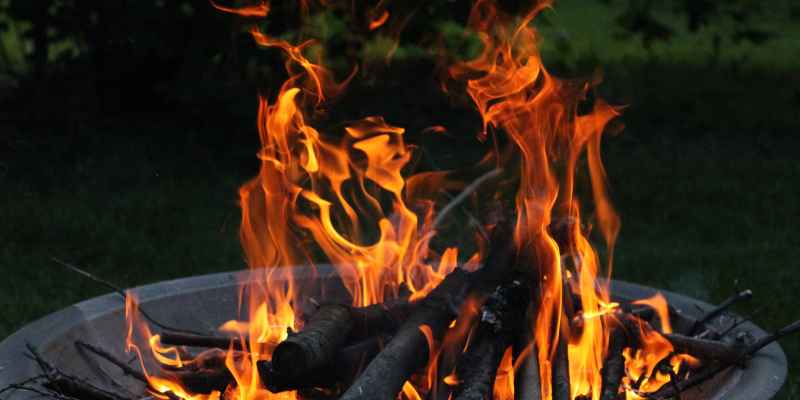To stack wood in a fire pit, start by placing two logs in an X configuration on the grate or fire pit with the top log angling up. Then, place firelogs with the arrows on the seam of the wrapper pointing down.
Finally, light the seam at the arrows of the bottom firelog. This method ensures proper air flow and efficient burning of the wood.
Choosing The Right Firewood
Choosing the right firewood is crucial for a successful and enjoyable fire pit experience. Here are some suitable wood types to consider:
- Hardwoods: Hardwood logs are the best choice for fire pits. They burn longer and produce more heat compared to softwoods. Popular hardwood options include oak, hickory, maple, and birch.
- Seasoned Wood: It is essential to use properly seasoned firewood. Seasoned wood has been dried for at least six months or more, reducing the moisture content. This makes the wood easier to ignite and burn more efficiently.
- Avoid Green/Wet Wood: Green or wet wood contains high moisture content, making it difficult to burn. It produces more smoke and less heat, resulting in a less enjoyable fire pit experience.
- Avoid Treated Wood: Treated wood, such as painted or pressure-treated wood, should not be used in fire pits. Burning treated wood releases harmful chemicals into the air, posing health risks.
Properly seasoned firewood plays a crucial role in achieving a successful and efficient fire pit. Here’s why it’s essential:
- Easy Ignition: Seasoned firewood ignites quickly and easily, saving you time and effort. It eliminates the need for excessive tinder and accelerants.
- Efficient Burning: Seasoned wood burns more efficiently and produces more heat. It allows you to maximize the warmth and ambiance of your fire pit.
- Less Smoke: Seasoned firewood produces less smoke compared to green or wet wood. This not only reduces air pollution but also keeps your outdoor area clean and free from unwanted smoke.
- Longer Burning Time: Properly seasoned wood burns longer, allowing you to enjoy your fire pit for extended periods. You won’t have to constantly add new logs, enhancing your overall fire pit experience.
By selecting suitable wood types and using properly seasoned firewood, you can stack your wood in the fire pit and create a warm and inviting atmosphere for gatherings, relaxation, or roasting marshmallows.
The Art Of Stacking
The way you stack wood in your fire pit can greatly impact how well your fire burns. Mastering the art of stacking is essential for creating a beautiful, efficient fire that provides warmth and ambiance. Let’s explore three popular methods of stacking wood: the TeePee Method, the Log Cabin Method, and the Cross-Stack Method.
The Teepee Method
- Start by placing larger logs vertically in a teepee shape.
- Stack smaller logs or kindling around the base of the teepee.
- Light the kindling at the center of the teepee to ignite the larger logs.
- As the fire grows, continue adding larger logs to the outer layer of the teepee.
The Log Cabin Method
- Begin by laying two large logs parallel to each other.
- Stack two more logs perpendicular to the first two, creating a square shape.
- Continue alternating between parallel and perpendicular logs to build up the structure.
- Leave small gaps between the logs to allow for airflow.
The Cross-stack Method
- Start by laying several logs side by side in a row.
- Layer more logs on top of the first row, perpendicular to the bottom logs.
- Continue stacking logs in a crisscross pattern to create a sturdy and efficient stack.
- Ensure that there are spaces between the logs for air circulation.
Each stacking method has its own benefits, so feel free to experiment and find which works best for your fire pit. Whether you prefer the simplicity of the TeePee Method, the structure of the Log Cabin Method, or the airflow of the Cross-Stack Method, proper stacking will ensure a successful fire pit experience.
Arranging Kindling And Tinder
To stack wood in a fire pit, begin with two logs arranged in an X shape on the grate. Place firelogs with the arrows pointing down and light at the seam. Add kindling and tinder in a teepee shape for efficient burning and a cozy fire.
Placing Kindling/tinder At The Center Of The Firepit
Start by placing a small amount of kindling and tinder in the center of the firepit.
Building A Teepee Shape With Smaller Wood Pieces
Create a teepee shape using smaller wood pieces around the kindling and tinder, ensuring proper air flow.
Optimizing Airflow

To ensure a roaring and efficient fire in your fire pit, it is crucial to optimize airflow. Proper airflow allows the fire to burn consistently and evenly, producing less smoke and more heat. In this section, we will explore two key aspects of optimizing airflow when stacking wood in a fire pit.
Allowing Space For Air Circulation
When stacking wood in a fire pit, it’s important to allow space for air circulation. Adequate airflow helps the fire burn efficiently and prevents smoky and uneven flames. Here’s how you can allow space for proper air circulation:
- Use a fire pit with an elevated grate: A fire pit with an elevated grate allows air to flow beneath the wood, promoting better combustion.
- Leave gaps between the logs: When stacking the logs, leave small gaps between them to allow air to circulate freely.
- Avoid stacking the wood too tightly: Stacking the wood too tightly restricts airflow and hinders combustion. Ensure there is enough space between the logs for air to flow.
Positioning Logs To Promote Proper Airflow
The positioning of logs in a fire pit also plays a significant role in optimizing airflow. By strategically placing the logs, you can maximize the intake of oxygen and achieve a cleaner and more efficient burn. Follow these tips to position logs for proper airflow:
- Start with two logs: Begin by placing two logs on the grate or fire pit in an X configuration, with the top log angling up. This allows for better airflow between the logs.
- Position firelogs correctly: If you’re using firelogs, make sure to position them with the arrows on the seam of the wrapper pointing down. This helps direct the airflow towards the fire.
- Light the fire correctly: When lighting the fire, focus on the seam at the arrows of the bottom firelog. This ensures that the fire starts from the bottom and allows for efficient airflow throughout.
By allowing space for air circulation and positioning the logs strategically, you can optimize the airflow in your fire pit and create a beautiful and efficient fire. Remember, a well-stacked fire not only provides warmth and ambiance but also helps reduce smoke and promotes a cleaner burn.
Best Practices For Lighting
Properly lighting a fire pit is essential for a satisfying and safe outdoor experience. Here are the best practices for lighting a fire pit to ensure a successful and enjoyable fire-building experience.
Selecting The Right Fire-starting Method
When beginning the lighting process, it is crucial to choose the appropriate fire-starting method. Whether using firelighters, kindling, or matches, selecting a method that suits your fire pit and the environment is a key consideration. The type of wood being used and the fire pit’s design will determine the best fire-starting method to use.
Ensuring A Proper Ignition Sequence
Ensuring a proper ignition sequence is fundamental to successfully lighting a fire pit. Start by placing the thickest logs in a row at the base of the fire pit, followed by another row of thick logs to build the core of the fire. Add a row or two of thinner logs, creating a layered structure. Then, stack kindling in the same fashion, and top it with firelighters before lighting the fire with a match. This sequence helps in building an efficient and scalable fire while maintaining safety measures throughout the process.
Positioning logs for a fire pit involves placing two logs in an X configuration on the grate, with the top log angling upward, and then adding firelogs with the arrows on the seam pointing down and lighting the fire at the arrows of the bottom firelog.
Remember, the success of lighting a fire in a fire pit depends on proper preparation, selection of suitable fire-starting methods, and igniting the sequence in a systematic manner. Following these best practices will ensure a well-established fire that provides warmth, ambiance, and enjoyment for everyone gathered around the fire pit.
Maintaining A Long-lasting Fire
Adding Additional Layers Of Wood
When it comes to maintaining a long-lasting fire in your fire pit, adding additional layers of wood plays a crucial role. After the initial fire is lit, continue to add more wood in layers to sustain the burning process. By adding more wood strategically, you can ensure that the fire burns steadily and consistently, allowing you to enjoy the warmth and ambiance of the fire for an extended period.
Promoting Consistent Burning
Promoting consistent burning is essential for sustaining a long-lasting fire in your fire pit. By properly stacking the wood, you can create a steady burn that will keep the fire going for a longer duration. The way you arrange the wood can significantly impact the airflow and the efficiency of the burning process. Therefore, it is important to stack the wood in a way that promotes consistent burning and maximizes the utilization of the firewood.

Frequently Asked Questions For How To Stack Wood In Fire Pit
How Do You Position Logs In A Fire Pit?
To position logs in a fire pit, start with two logs in an X configuration on the grate or fire pit. Angle the top log upwards. Place firelogs with the arrows pointing down and light the bottom firelog at the arrows.
How Do You Lay Wood In A Fire Pit?
To lay wood in a fire pit, start with two logs in an X shape on the grate. Place firelogs with arrows pointing down and light at the seam. Build the fire by adding more logs and kindling, then light with a match to ensure a good fire.
How Do You Stack Logs In A Fireplace Fire?
To stack logs in a fireplace fire, start with two logs in an X position on the grate. Angle the top log upwards, then place firelogs with the arrows pointing down. Light the bottom firelog at the arrows to start the fire.
You’re all set!
How Do You Stack Firewood So It Dries?
To stack firewood for drying, follow these steps: 1. Start with two logs placed in an X shape on a grate or fire pit. 2. Angle the top log upward. 3. Place firelogs with arrows pointing down. 4. Light the seam at the arrows on the bottom firelog.
By following this method, the firewood will dry efficiently.
Conclusion
When it comes to stacking wood in a fire pit, following the right method is essential for a successful and efficient fire. By starting with two logs in an X configuration and placing firelogs with the arrows pointing down, you can ensure a proper ignition.
Remember to let the fire breathe and add more layers of wood as needed. Following these guidelines, you can enjoy a cozy and warm fire pit experience.


